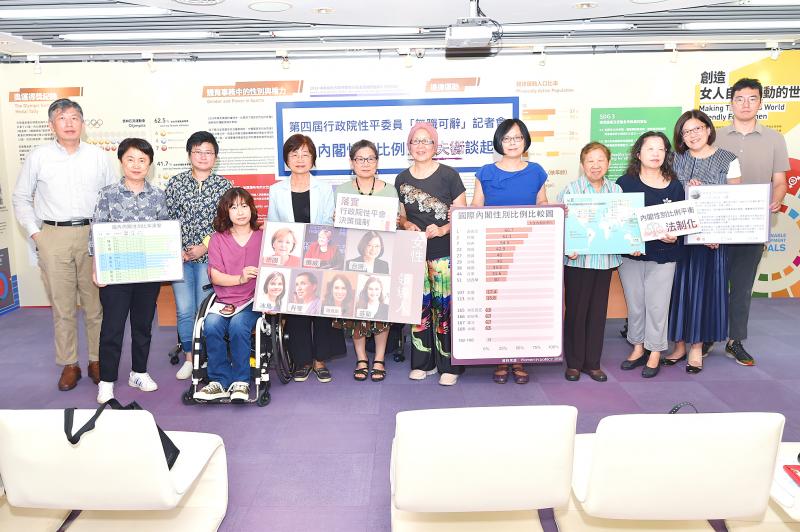President Tsai Ing-wen (蔡英文) and Premier Su Tseng-chang (蘇貞昌) need to create a more gender-balanced Cabinet, several outgoing members of the Fourth Gender Equality Committee said yesterday.
Taiwan Alliance to Promote Civil Partnership Rights cofounder Victoria Hsu (許秀雯) said that she and other members whose two-year term ended yesterday believe the gender ratio of the Cabinet is “severely unbalanced.”
Despite the progress the nation has made over the past few years in gender equality, and the election and re-election of the nation’s first female president, why is the current Cabinet the “most male?” asked Hsu, who also served on the Third Gender Equality Committee.

Photo: Tu Chien-jung, Taipei Times
Taipei Women’s Rescue Foundation member Huang Shu-ling (黃淑玲) said women make up just 6.9 percent of the new Cabinet.
National Alliance of Taiwan Women’s Associations member Chen Hsiu-hui (陳秀惠) said that after protests from women’s groups, Tsai in May 2016 wrote on Facebook that her administration would try to make up for its shortcoming in terms of the gender ratio of Cabinet members.
Chen said she was worried the nation’s first female president would become the nation’s only one.
The emergence of the next female president should not be left to chance, Hsu said.
The outgoing committee members urged the government to establish laws governing the Cabinet’s gender ratio in line with the UN’s Convention on the Elimination of All Forms of Discrimination Against Women, for which the legislature on May 20, 2011, passed an enforcement act that took effect on Jan. 1, 2012.
The Gender Equality Committee consists of 27 to 35 members, including the premier and vice premier, who serve as convener and deputy convener respectively.
Committee members are appointed by the premier and can include up to nine professionals selected from among the public, and nine representatives from gender or women’s groups.
Executive Yuan spokesman Ting Yi-ming (丁怡銘) said the government would take the suggestions into consideration.
A list of new committee members would be announced after Su approves it, he added.
Additional reporting by CNA

US climber Alex Honnold is to attempt to scale Taipei 101 without a rope and harness in a live Netflix special on Jan. 24, the streaming platform announced on Wednesday. Accounting for the time difference, the two-hour broadcast of Honnold’s climb, called Skyscraper Live, is to air on Jan. 23 in the US, Netflix said in a statement. Honnold, 40, was the first person ever to free solo climb the 900m El Capitan rock formation in Yosemite National Park — a feat that was recorded and later made into the 2018 documentary film Free Solo. Netflix previewed Skyscraper Live in October, after videos

NUMBERS IMBALANCE: More than 4 million Taiwanese have visited China this year, while only about half a million Chinese have visited here Beijing has yet to respond to Taiwan’s requests for negotiation over matters related to the recovery of cross-strait tourism, the Tourism Administration said yesterday. Taiwan’s tourism authority issued the statement after Chinese-language daily the China Times reported yesterday that the government’s policy of banning group tours to China does not stop Taiwanese from visiting the country. As of October, more than 4.2 million had traveled to China this year, exceeding last year. Beijing estimated the number of Taiwanese tourists in China could reach 4.5 million this year. By contrast, only 500,000 Chinese tourists are expected in Taiwan, the report said. The report

Temperatures are forecast to drop steadily as a continental cold air mass moves across Taiwan, with some areas also likely to see heavy rainfall, the Central Weather Administration (CWA) said. From today through early tomorrow, a cold air mass would keep temperatures low across central and northern Taiwan, and the eastern half of Taiwan proper, with isolated brief showers forecast along Keelung’s north coast, Taipei and New Taipei City’s mountainous areas and eastern Taiwan, it said. Lows of 11°C to 15°C are forecast in central and northern Taiwan, Yilan County, and the outlying Kinmen and Lienchiang (Matsu) counties, and 14°C to 17°C

STEERING FAILURE: The first boat of its class is experiencing teething issues as it readies for acceptance by the navy, according to a recent story about rudder failure The Hai Kun (海鯤), the nation’s first locally built submarine, allegedly suffered a total failure of stern hydraulic systems during the second round of sea acceptance trials on June 26, and sailors were forced to manually operate the X-rudder to turn the submarine and return to port, news Web site Mirror Daily reported yesterday. The report said that tugboats following the Hai Kun assisted the submarine in avoiding collisions with other ships due to the X-rudder malfunctioning. At the time of the report, the submarine had completed its trials and was scheduled to begin diving and surfacing tests in shallow areas. The X-rudder,